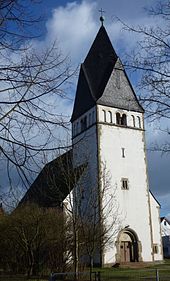Greppin
|
Greppin
City of Bitterfeld-Wolfen
|
|
|---|---|
| Coordinates: 51 ° 38 ′ 33 ″ N , 12 ° 18 ′ 11 ″ E | |
| Height : | 76 m |
| Area : | 8.17 km² |
| Residents : | 2322 (Jun. 30, 2017) |
| Population density : | 284 inhabitants / km² |
| Incorporation : | July 1, 2007 |
| Postal code : | 06803 |
| Area code : | 03493 |
Greppin is a district of the town of Bitterfeld-Wolfen in the Anhalt-Bitterfeld district in the south-east of Saxony-Anhalt .
geography
The Greppin district is located southwest of the Mulde between the two districts of Wolfen and Bitterfeld of the newly formed city.
history
Greppin was first mentioned in a document in 1390. The place belonged with the neighboring residential area Wachtendorf until 1815 to the electoral office of Bitterfeld . The decisions of the Congress of Vienna they came to Prussia and were in 1816 the district Bitterfeld in the administrative district of Merseburg of the Province of Saxony allocated. The district existed until 1952 and as the Bitterfeld district on a smaller scale until 1990. In May 1990 the Bitterfeld district was reorganized. Greppin was a member of this group and merged with him into the Anhalt-Bitterfeld district, which was founded in 2007 .
In Greppin a witch trial was carried out in 1701 as part of the witch hunt against a citizen named Andreas Blume , the outcome of which is unknown.
In 1846, lignite was discovered on the edge of Greppin and mined in the following decades. The clay deposits that were also discovered were initially used for the production of simple bricks from 1860 onwards. Greppin has had a railway connection since 1857, with which the extracted lignite and bricks could be transported away more easily.
With the founding of Greppiner Werke in 1872 and modernization of the kilns, high-quality clinker bricks could be fired here, which were known nationwide as Greppiner clinker and were used for numerous representative buildings in the period from 1872 to around 1900, including the Anhalter Bahnhof in Berlin. The Greppin works were closed and dismantled in 1932.
In 1896 Agfa set up a paint factory in Greppin, in which 944 workers were employed at the end of 1907.
From 1932 until the turn of 1990, toxic and strongly smelling waste and wastewater from chemical production were discharged into the open pit. Under the ironic name Silver Lake , coined by the vernacular , this landfill became a synonym for the environmental pollution in the GDR due to the careless dumping of chemical waste.
On July 1, 2007, the autonomy of the Greppin municipality ended when it was incorporated into the newly formed town of Bitterfeld-Wolfen. Local mayor has been Joachim Schunke (Free Voters Anhalt-Bitterfeld) since the last local elections.
Population development
| year | Residents |
|---|---|
| 1970 | 6779 |
| 2005 | 2835 |
| 2008 | 2673 |
politics
coat of arms
The coat of arms was approved by the Dessau Regional Council on October 12, 1993 and registered in the Magdeburg State Archives under the coat of arms roll number 44/1993.
Blazon : "In silver, a black cooling tower with black smoke, accompanied by three red sea leaves."
The colors of the community are black - silver (white).
The coat of arms was designed by the Magdeburg municipal heraldist Jörg Mantzsch and included in the approval process.
Culture and sights
- Greppin has both a Protestant and a Catholic church. The Catholic Holy Spirit Church was profaned on the day of the celebration of the 100th consecration day, on Whit Monday 2017 .
- The place borders in the east on the Muldenaue , an animal enclosure is on the way to the floodplain.
- In the local cemetery , a collective grave of five Italians , four French and one Serb commemorates people who were deported to Germany during the Second World War and who were victims of forced labor .
Economy and Infrastructure
traffic
The Dessau – Bitterfeld – Leipzig railway runs directly through the district. Greppin has a stop at this, which is served every hour by the S2 Dessau - Bitterfeld - Leipzig - Stötteritz and the S8 Dessau - Bitterfeld - Halle of the S-Bahn Central Germany . The city bus routes 406 and 410 also operate here.
The federal highway 184 leads past Greppin to the west. The nearby A 9 can be reached via the Bitterfeld junction about 8 km away.
education
- Primary School (Neue Strasse 32)
environment
The environment of Greppin (especially the groundwater) is highly polluted with pollutants, due to the industrial prehistory such as the GDR chemical production . The groundwater is part of the so-called “northeastern drainage bar” and will remain contaminated in the long term. The Greppins groundwater is so heavily polluted that until today z. B. is not advised to grow fruit / vegetables in your own garden. It contains u. a. toxic chlorobenzenes, halogenated chlorinated hydrocarbons and lindane.
Personalities
- Gerhard Hoehme (1920–1989), German painter and graphic artist
- Walter Möbius (1902–1979), local painter and graphic artist
- Max Müller (1914–1944), musician, 1st Kapellmeister at the Gdansk State Symphony Orchestra
Individual evidence
- ↑ Wachtendorf on gov.genealogy.net
- ^ Karlheinz Blaschke , Uwe Ulrich Jäschke : Kursächsischer Ämteratlas. Leipzig 2009, ISBN 978-3-937386-14-0 ; P. 22 f.
- ^ The district of Bitterfeld in the municipality register 1900
- ↑ Wilde, Manfred: The sorcery and witch trials in Kursachsen, Cologne, Weimar, Vienna 2003, p. 517.
- ↑ StBA Area: changes from 01.01. until December 31, 2007
- ↑ Contaminant concept, sediment management status .
- ↑ Stefan Schröter: Protection against toxic groundwater Greppin should get an underground wall .




